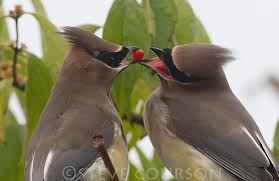(Bombycilla cedrorum Bombycillidae family)

The cedar waxwing is a smooth sleek bird with a short square-tipped tail, broad pointed wings, wide stubby bill and a crest that may lie flat over the back of the head. In color the cedar waxwing is pale brown on the head and chest fading to soft gray on the wings. The belly is pale yellow and the tail is gray with a bright yellow tip. The face has a narrow black mask neatly outlined in white. The wing feathers have waxy red tips.
The cedar waxwing call is a very high and slightly sibilant shree. This is often the first indicator that a flock of cedar waxwings is nearby.
The cedar waxwing compares to the European starling in flight.
The cedar waxwings summer breeding range extends from the south half of Canada to the north half of the United States. The winter range stretches from the United States south to Panama. They will be migrating through Georgia in January and February. Some have already been spotted in the Atlanta area.
You rarely see single cedar waxwings. These highly social birds break into pairs in midsummer for mating, but otherwise they are almost always in groups.
The cedar waxwing lives in open woodlands, orchards and residential areas, especially those with an abundance of trees and bushes bearing fruit and berries. Cedar waxwings are frugivorous meaning most of their diet is made up of berries and fruits. They also eat sap, flowers and the occasional insect. Cedar waxwings are voracious eaters and often descend upon a shrub or tree enmass and leave only when every berry has been consumed. The person who coined the phrase “eat like a horse” obviously wasn’t familiar with cedar waxwings. Click image for more info.
Fun Facts:
The male courts a female by doing a hopping dance and passing berries or pieces of fruit to her. If the female is interested, she will do a hopping dance and pass the fruit or berry back to the male. •Cedar waxwings are very social. They are non-territorial and will often groom each other.
•Cedar waxwings sometimes consume fruit that has fermented on the vine. They are disoriented by the alcohol content of the fruit and may fly irregularly and have trouble perching on branches.
•The winter range of the cedar waxwing has been extended south in recent years. This may be due to the increase in backyard habitat with fruit bearing shrubs.
•Recently cedar waxwings have been observed with orange tipped tails. This seems to be due to a diet of berries from an introduced species of honeysuckle (Morrow Honeysuckle).

